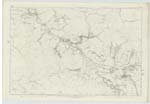OS1/3/21/34
| List of names as written | Various modes of spelling | Authorities for spelling | Situation | Description remarks |
|---|---|---|---|---|
| LAIGHT CASTLE | 046 | [Continued] However as the Register of St. Andrew States (this Register is the most ancient voucher on record) that he was buried, Mr. Walker says that a Stone (called Hare Stone) on the Greenhill of Waterside is the Supposed place where the Standard was placed during the battle, which was fought partly on this Side and partly at the north foot of that hill and in view of the Grave of Alpin according to the above register. The Chronicles of Dunblane make mention of a bloody battle fought about this place. See Chalmers Caledonia for A long History of all about this battle Alpin and Castle &c &c |
Continued entries/extra info
[Page] 34Parish of Dalmellington
[Continued from previous page]
"the country as he proceeded, until he reached the ridge of the hills
"at Dalmellington, which separates Kyle from Kirkcudbright. He
" was then met by the assembled warriors of the invaded territory,
"and a severe conflict ensued. Alpin was killed, and the spot
"where he was buried afterwards bore the name of Laicht Alpin,
" or the grave of Alpin ** The grave-stone of Alpin, however, has
"long ago disappeared, so that it is impossible to pint out the precise
"spot of his interment. The Castle of Laicht, which, no doubt,
" took its name from the burial-place, has also been rased to the
" ground; the greater part of the ruins having been carried away
" by the proprietors, to build enclosures, about the year 1770. ** 'the
"workmen had much difficulty in demolishing it', the walls
"were thick, and the stones thoroughly cemented. The site, however,
"and a portion of the foundation, are still plainly distinguishable".
Patterson's History of Ayrshire (1847)
"The tradition of the district is that Alpin, being on his retreat,
" slept in the castle the night before the battle which terminated his career.
" So far as is known, there were no castles in existence at that period. Still
"the site may have been a stronghold previously. From the form of the
"trench, which is circular, the castle seems to have been one of the
"earliest. The position is precisely similar to that of Canmore's tower at
" Dunfermline, and appears to have been constructed on the same principle."
Patterson's History of Ayrshire (1847)
"Malcolm Canmore ascended
"the throne in 1057, prior to which, it is
"believed, there were no castles or strong
"towers in the country, save, perhaps,
"a few huge buildings on the sea-coast,
"supposed to have been erected by the
" Danish Vikings. The round tower erected
"by Malcolm at Dunfermline, immediately
"after his accession to the throne, is believed
"to have been the first building of the kind.
"Keeping this in view, in reference to the
" tradition of Dalmellington, we find it
"said that there were three castles - namely
"Dalmellington, Laight & Keirs - within
" sight of each other, which belonged to
"three sisters". Patterson's Hist. [History] of Ayrshire
Transcribers who have contributed to this page.
Chr1smac -Moderator, hillhere
Location information for this page.
Linked mapsheets.




